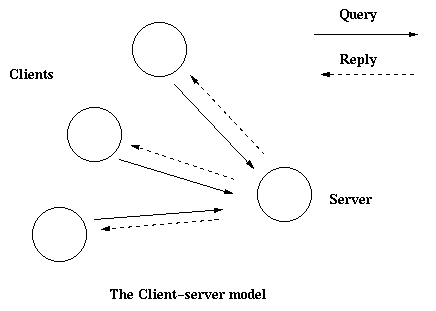2 Gen_Server Behaviour
This chapter should be read in conjunction with gen_server(3), where all interface functions and callback functions are described in detail.
2.1 Client-Server Principles
The client-server model is characterized by a central server and an arbitrary number of clients. The client-server model is generally used for resource management operations, where several different clients want to share a common resource. The server is responsible for managing this resource.

Figure 2.1: Client-Server Model
2.2 Example
An example of a simple server written in plain Erlang was given in Overview. The server can be re-implemented using gen_server, resulting in this callback module:
-module(ch3).
-behaviour(gen_server).
-export([start_link/0]).
-export([alloc/0, free/1]).
-export([init/1, handle_call/3, handle_cast/2]).
start_link() ->
gen_server:start_link({local, ch3}, ch3, [], []).
alloc() ->
gen_server:call(ch3, alloc).
free(Ch) ->
gen_server:cast(ch3, {free, Ch}).
init(_Args) ->
{ok, channels()}.
handle_call(alloc, _From, Chs) ->
{Ch, Chs2} = alloc(Chs),
{reply, Ch, Chs2}.
handle_cast({free, Ch}, Chs) ->
Chs2 = free(Ch, Chs),
{noreply, Chs2}.The code is explained in the next sections.
2.3 Starting a Gen_Server
In the example in the previous section, the gen_server is started by calling ch3:start_link():
start_link() ->
gen_server:start_link({local, ch3}, ch3, [], []) => {ok, Pid}start_link calls the function gen_server:start_link/4. This function spawns and links to a new process, a gen_server.
-
The first argument {local, ch3} specifies the name. In this case, the gen_server will be locally registered as ch3.
If the name is omitted, the gen_server is not registered. Instead its pid must be used. The name could also be given as {global, Name}, in which case the gen_server is registered using global:register_name/2.
-
The second argument, ch3, is the name of the callback module, that is the module where the callback functions are located.
In this case, the interface functions (start_link, alloc and free) are located in the same module as the callback functions (init, handle_call and handle_cast). This is normally good programming practice, to have the code corresponding to one process contained in one module.
-
The third argument, [], is a term which is passed as-is to the callback function init. Here, init does not need any indata and ignores the argument.
-
The fourth argument, [], is a list of options. See gen_server(3) for available options.
If name registration succeeds, the new gen_server process calls the callback function ch3:init([]). init is expected to return {ok, State}, where State is the internal state of the gen_server. In this case, the state is the available channels.
init(_Args) ->
{ok, channels()}.Note that gen_server:start_link is synchronous. It does not return until the gen_server has been initialized and is ready to receive requests.
gen_server:start_link must be used if the gen_server is part of a supervision tree, i.e. is started by a supervisor. There is another function gen_server:start to start a stand-alone gen_server, i.e. a gen_server which is not part of a supervision tree.
2.4 Synchronous Requests - Call
The synchronous request alloc() is implemented using gen_server:call/2:
alloc() ->
gen_server:call(ch3, alloc).ch3 is the name of the gen_server and must agree with the name used to start it. alloc is the actual request.
The request is made into a message and sent to the gen_server. When the request is received, the gen_server calls handle_call(Request, From, State) which is expected to return a tuple {reply, Reply, State1}. Reply is the reply which should be sent back to the client, and State1 is a new value for the state of the gen_server.
handle_call(alloc, _From, Chs) ->
{Ch, Chs2} = alloc(Chs),
{reply, Ch, Chs2}.In this case, the reply is the allocated channel Ch and the new state is the set of remaining available channels Chs2.
Thus, the call ch3:alloc() returns the allocated channel Ch and the gen_server then waits for new requests, now with an updated list of available channels.
2.5 Asynchronous Requests - Cast
The asynchronous request free(Ch) is implemented using gen_server:cast/2:
free(Ch) ->
gen_server:cast(ch3, {free, Ch}).ch3 is the name of the gen_server. {free, Ch} is the actual request.
The request is made into a message and sent to the gen_server. cast, and thus free, then returns ok.
When the request is received, the gen_server calls handle_cast(Request, State) which is expected to return a tuple {noreply, State1}. State1 is a new value for the state of the gen_server.
handle_cast({free, Ch}, Chs) ->
Chs2 = free(Ch, Chs),
{noreply, Chs2}.In this case, the new state is the updated list of available channels Chs2. The gen_server is now ready for new requests.
2.6 Stopping
In a Supervision Tree
If the gen_server is part of a supervision tree, no stop function is needed. The gen_server will automatically be terminated by its supervisor. Exactly how this is done is defined by a shutdown strategy set in the supervisor.
If it is necessary to clean up before termination, the shutdown strategy must be a timeout value and the gen_server must be set to trap exit signals in the init function. When ordered to shutdown, the gen_server will then call the callback function terminate(shutdown, State):
init(Args) ->
...,
process_flag(trap_exit, true),
...,
{ok, State}.
...
terminate(shutdown, State) ->
..code for cleaning up here..
ok.Stand-Alone Gen_Servers
If the gen_server is not part of a supervision tree, a stop function may be useful, for example:
...
export([stop/0]).
...
stop() ->
gen_server:cast(ch3, stop).
...
handle_cast(stop, State) ->
{stop, normal, State};
handle_cast({free, Ch}, State) ->
....
...
terminate(normal, State) ->
ok.The callback function handling the stop request returns a tuple {stop, normal, State1}, where normal specifies that it is a normal termination and State1 is a new value for the state of the gen_server. This will cause the gen_server to call terminate(normal,State1) and then terminate gracefully.
2.7 Handling Other Messages
If the gen_server should be able to receive other messages than requests, the callback function handle_info(Info, State) must be implemented to handle them. Examples of other messages are exit messages, if the gen_server is linked to other processes (than the supervisor) and trapping exit signals.
handle_info({'EXIT', Pid, Reason}, State) ->
..code to handle exits here..
{noreply, State1}.